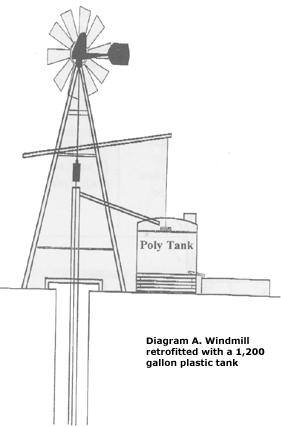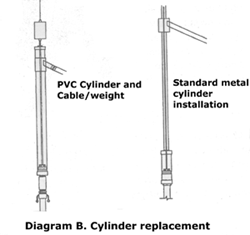You are here: PFRA Online > Clean Water > Water Supply
Windmills: economical retrofitting
Windmills have been used to pump prairie ground water for over 100 years. In fact, some of the
existing windmills found on PFRA community pastures were originally purchased by local
farmers before the conception of PFRA and the community pasture system. Overall, these
windmills have proven to be both durable and economical for delivering ground water to remote
areas. Although they have been quite "bullet proof", certain servicing problems recur with parts
of the unit. This article outlines some of the more common problems along with some ways in
which these problems can be solved.

Problems
- The pump on most windmills has a brass or cast iron cylinder. This cylinder requires a fair
amount of servicing: cup leathers and flapper valves need to be replaced and, each fall, the unit
must be drained so that it does not freeze. Replacement is expensive if the unit freezes and
cracks.
- Usually, problems occur with the wooden "pitman rod" or stick, which runs from the
windmill head down to the cylinder rod. This stick must lift the plunger in the cylinder and force
it down on the down stroke. Any obstruction on the down stroke can break the stick; too much
resistance at high turning speeds will also break it.
- One other main criticism of windmills concerns the float. Generally, a wooden float
(located in the stockwater trough) acts as a break on the windmill when the trough is full of
water. This float also releases the "brakes" when the water level is low. The criticism is that this
float assembly does not release the brake soon enough and stockwater shortages can occur.
Retrofitting
Over the years, many PFRA staff have come up with several modifications that reduce servicing
and also improve the overall efficiency of these old windmills. A typical windmill retrofit
involves replacing the pump cylinder, making a new stick, and adding a poly water storage tank!

- The pump cylinder can be replaced with a PVC "working barrel" (see diagram B). This
barrel is actually a 3 inch schedule 40 PVC pipe with a 3 inch double leather brass plunger, and a
7/16 inch galvanized pump rod. At the bottom of the working barrel is a 2 inch brass check
valve with a spring loaded rubber seal. This is a big improvement over the leather flapper check
valve in the old cylinder pump! The top of the working barrel is made of a 3 x 3 x 2 inch "Tee
fitting" with a 3 inch cap. The cap is then drilled to accommodate the pump rod. A 2 inch PVC
pipe runs from the working barrel to the water tank.
Note: on sand point wells, the working barrel is attached to the sand point with aluminum "quick
couplers". This makes removal and drainage very easy - no tools are needed!
- The stick above the working barrel can be replaced with a 5/16 inch cable with a 20 pound
weight on the end (Diagram B). This weight keeps any slack out of the cable and this eliminates
any jerks to the windmill head at high working speeds.
- The last part of a retrofit is the addition of a 1200 gallon plastic poly tank (Diagram A).
The tank is set above the stock watering troughs so that water can be gravity fed to the troughs.
The float for the windmill is then moved into the poly tank. This change allows the windmill to
start pumping much sooner. Extra water storage means a more reliable water supply when either
the wind stops blowing or a breakdown occurs unexpectedly.
Results
These windmill modifications work well. Down time of windmills is reduced and water storage
is increased by more than 1000 gallons by adding the poly tanks; the water troughs are still full
when the windmill begins to pump. All this for less than $1000.00!
|
